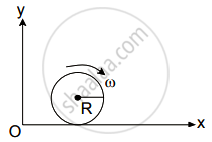Advertisements
Advertisements
Question
Find the components along the x, y, z axes of the angular momentum l of a particle, whose position vector is r with components x, y, z and momentum is p with components px, py and 'p_z`. Show that if the particle moves only in the x-y plane the angular momentum has only a z-component.
Solution
lx = ypz – zpy
ly = zpx – xpz
lz = xpy –ypx
Linear momentum of the particle,`vecp = p_x hati + p_y hatj + p_z hatk`
Position vector of the particle, `vecr = xhati + yhatj + zhatk`
Angular momentum, `hatl = hatr xx hatp`
=`(xhati + yhatj + zhatk) xx (p_x hati + p_y hatj + p_z hatk)`
`=|(hati,hatj,hatk),(x,y,z), (p_x, p_y,p_z)|`
`l_xhati + l_yhatj + l_z hatk = hati (yp_z - zp_y) - hatj(xp_z - zp_x) + hatk (xp_y - zp_x)`
Comparing the coefficients of `hati, hatj, hatk` we get:
`((l_x = yp_z - zp_y),(l_y = xp_z -zp_x),(l_z = xp_y - yp_x))}...(i)`
The particle moves in the x-y plane. Hence, the z-component of the position vector and linear momentum vector becomes zero, i.e.,
z = pz = 0
Thus, equation (i) reduces to:
`((l_x=0),(l_y=0),(l_z=xp_y -yp_x))} `
Therefore, when the particle is confined to move in the x-y plane, the direction of angular momentum is along the z-direction.
APPEARS IN
RELATED QUESTIONS
A solid cylinder of mass 20 kg rotates about its axis with angular speed 100 rad s–1. The radius of the cylinder is 0.25 m. What is the kinetic energy associated with the rotation of the cylinder? What is the magnitude of the angular momentum of the cylinder about its axis?
The torque of a force \[\overrightarrow F \] about a point is defined as \[\overrightarrow\Gamma = \overrightarrow r \times \overrightarrow F.\] Suppose \[\overrightarrow r, \overrightarrow F\] and \[\overrightarrow \Gamma\] are all nonzero. Is \[r \times \overrightarrow\Gamma || \overrightarrow F\] always true? Is it ever true?
If several forces act on a particle, the total torque on the particle may be obtained by first finding the resultant force and then taking torque of this resultant. Prove this. Is this result valid for the forces acting on different particles of a body in such a way that their lines of action intersect at a common point?
A particle of mass m is projected with a speed u at an angle θ with the horizontal. Find the torque of the weight of the particle about the point of projection when the particle is at the highest point.
A flywheel of moment of inertia 5⋅0 kg-m2 is rotated at a speed of 60 rad/s. Because of the friction at the axle it comes to rest in 5⋅0 minutes. Find (a) the average torque of the friction (b) the total work done by the friction and (c) the angular momentum of the wheel 1 minute before it stops rotating.
State conservation of angular momentum.
A particle of mass 5 units is moving with a uniform speed of v = `3sqrt 2` units in the XOY plane along the line y = x + 4. Find the magnitude of angular momentum
Two discs of moments of inertia I1 and I2 about their respective axes (normal to the disc and passing through the centre), and rotating with angular speed ω2 and ω2 are brought into contact face to face with their axes of rotation coincident.
- Does the law of conservation of angular momentum apply to the situation? why?
- Find the angular speed of the two-disc system.
- Calculate the loss in kinetic energy of the system in the process.
- Account for this loss.
A spherical shell of 1 kg mass and radius R is rolling with angular speed ω on horizontal plane (as shown in figure). The magnitude of angular momentum of the shell about the origin O is `a/3 R^2` ω. The value of a will be:

A solid sphere is rotating in free space. If the radius of the sphere is increased while keeping the mass the same, which one of the following will not be affected?
